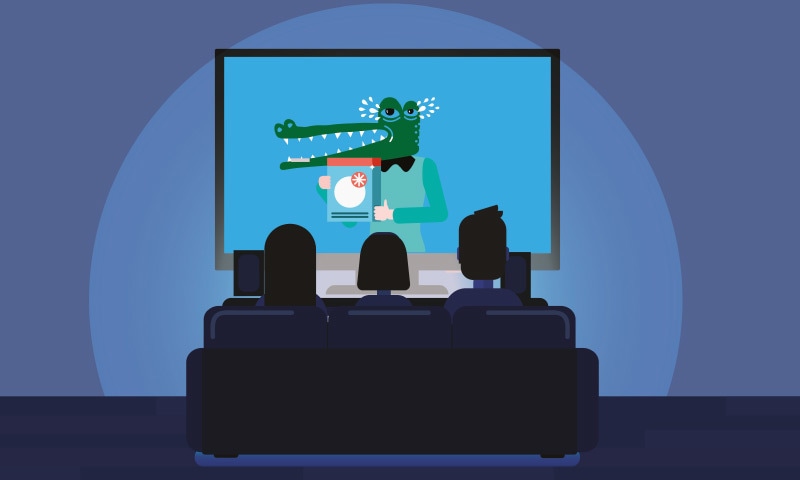Bring on the (Crocodile) Tears
This might come as a bit of a shock. But there is no one singular emotion. There are seven scientifically validated emotions – anger, fear, disgust, contempt, joy, sadness and surprise – which usually show up in neuro-scientific tests. Eight, according to Robert Putchik (he adds anticipation). Fourteen according to Aristotle (I’m guessing the number of emotions was whittled down as time passed and humans became hardier beings.)Yet we receive (and give) briefs asking for an emotional campaign without actually specifying which particular emotion should be at the centre of the story, because in the context of advertising, ‘emotional’ translates into one thing: Dil pay ja kar lagna chahiye, rula do sab ko. And in doing so, we reduce ourselves and our consumers to caricatures. We generalise feelings and everything that makes us human to one superficial gesture.
How do we want people to feel after they see our ad? Do we want people to feel happy in the end? Excited? Do we really need to make people cry or should we just leave them with some food for thought? Do they really need to feel sad or guilty?
The only emotions we should be working with are joy, surprise and anticipation if we want people to have a positive association with our brand and achieve recall. I still remember the National Foods Eid ad from a few years ago, because it made me feel happy. It was heart-warming (another much abused word), but joyful too. The Morven Gold ad from the nineties is still quoted because it evoked surprise. The Indigo series ad featuring Shan and Vaneeza worked because it had the emotion of anticipation – what is going to happen next? The Pepsi ads from the nineties are still recalled because they evoked joy.
Yet, despite knowing all this, we still aim for intense, serious, tear-jerkers. We are multidimensional creatures when it comes to what we feel, why we feel it and when we feel it. Why is our advertising not reflecting this?

Speaking of tears. This end goal of tears usually starts with a well-meaning social change trigger. This sudden attachment to social change comes from FOMO – straight and simple – everyone is doing it, why not me? Unfortunately, no matter how sincere and relevant the social cause is, it never amounts to anything more than a one-dimensional one-off. We get the required likes and ‘talkability’ and move on to the next social cause. Which brings me to the second ask that usually accompanies the brief: ‘It has to go viral’.
While we all aspire to achieve the next Dove, none of us are willing to commit to one cause over an extended period of time. It is forever doomed to be a one-off. That one burst of melodrama with a superficial connect to a social cause. The commitment to real beauty by Dove was not made to achieve likes with a single campaign. The Real Beauty campaign started in 2004 (before social media took control of our lives) with a photography exhibition celebrating real beauty. This was followed by billboards featuring real women, leading up to that iconic commercial. It was based on a survey of 3,000 women done over months in 10 countries and has persisted for over 15 years. There have been countless events, activations, a play and a book. Even product innovation, with body wash bottles designed to reflect different body types.
No one brand in Pakistan will commit to a campaign that has social change as part of its philosophy. It never goes beyond that single viral campaign. And it is exploitative – of poverty porn and rich privilege. Look how wonderful I am for sharing my meal with my office peon. Look at us, so benevolent with our household help.
In a county that has such inequitable disparity between the rich and the poor, to pay feeble lip-service to the under-privileged is inexcusable. When a brand exploits this sentiment on World Food Day but does nothing to commit to reducing the food gap in any way, it is being irresponsible. The right thing to do would have been to pledge X amount to a food kitchen. To set up food kitchens. To perhaps partner with the Robin Hood Army to prevent food being wasted. Or sponsor seminars on the issue – we are an incredibly wasteful nation by the way. And continue the campaign on digital with an awareness building initiative. If we have to look at it from a marketing lens then this was an opportunity wasted. In addition to going viral, the brand would have been associated with something meaningful. Instead, they were content with their viral hits and the tears in the eyes of those who saw it.
I am hopeful that this trend of social causes will not die the death it appears destined to at this moment but change into something deeper. The sadvertising trend (apparently there is a name for this) needs to evolve into mature and consistent advertising that takes a stand and sticks with it. Like Lego choosing to reconsider their association with a major petroleum company after pressure from Greenpeace and investing millions in climate change projects. Or Levi’s commitment to reduce water usage in the manufacture of their jeans. Or Nike’s stand for Colin Kaepernick; despite the conservative backlash and sneaker burning videos, stocks soared. Toms famously donate one pair of shoes for every pair sold. As does Warby Parker with glasses. Both to people in need.
Until then, take out your hankies. And brace yourself. For Ramzan is around the corner. And so is a whole new spate of sadvertising.
S. Hyder is a creative working in a Pakistani advertising agency.



Comments (0) Closed